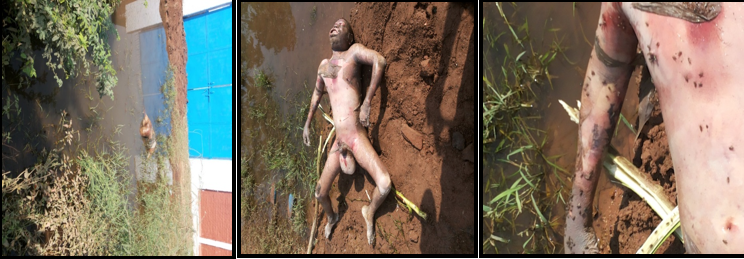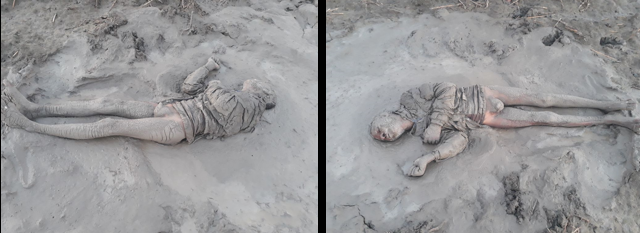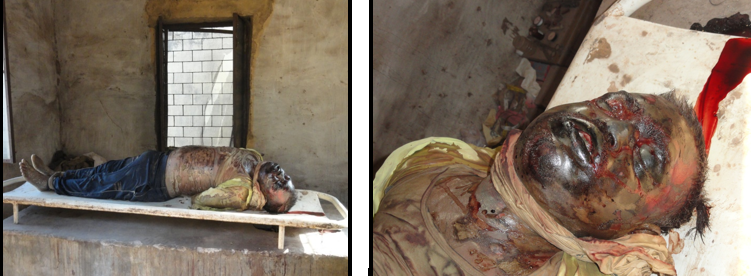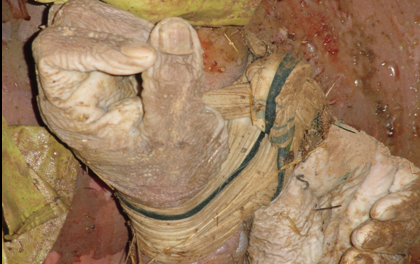- Visibility 161 Views
- Downloads 4 Downloads
- DOI 10.18231/j.ijfmts.2021.026
-
CrossMark
- Citation
Forensic significance in the cases of drowning deaths: An elaborative study
- Author Details:
-
Rinkal Chaudhary *
-
Vinod Dhingra
Introduction
Drowning is asphyxia in nature which prevents entering of air into the lungs via inhalation of fluid into air passages i.e., nose and mouth.[1] In drowning cases the death is caused by irreversible brain damage which occurs the development of irreversible cerebral anoxia and hypoxia. The several phases have been described during the drowning process, first a breath-holding phase, followed by involuntary inspiration, gasping for air and loss of consciousness. The state of consciousness is generally developed within three minutes of submersion.[2] Death of a victim found in water should not always be related to drowning so the diagnosis of drowning is one of the most difficult tasks in the field of forensic medicine. The finding out the cause of death in those cases is challenging. Only a systematic examination and complete autopsy can determine the death as presence of asphyxia symptoms of drowning.[3] In general, it is also found that the physical/external and autopsy examinations are not as specific in drowning cases as complete laboratory examination.[4] However, the majority of bodies found in water are typically determined the death from asphyxia due to drowning and in many cases ischemic cardiovascular disease, also act as a contributing factor. Many further investigations also proved that underlying natural diseases may contribute to cause death in water. In some circumstances, the cause of death is homicidal while others are natural due to some intoxication, influence of drugs and alcohol or lack of swimming ability.[5] In the recovered bodies from drowning deaths, it is still a challenge to ascertain a death due to the absence of typical post mortem findings.[6] In these circumstances the presence of diatoms is only screening method which is reliable and it signifies a microbial fingerprint of the time and place of occurred drowning.[7] This diatom test is very important examination to determine the drowning was antemortem or postmortem in nature.[8] In drowning related deaths, diatoms get deposited in the internal organs i.e., Kidney, liver, lung, brain and in the bone-marrow of the bones i.e., long bones. This is due to the inhalation of water that would penetrates into the blood circulation from alveoli through the alveolar spaces of lungs enter in the alveolar spaces.[9], [10], [11], [12] Though, in antemortem drowning the entering of any diatom in lungs with water is not possible. It would not be transported to distant body organs due to the lack of blood circulation. According to the Forensic law of comparison “Only the likes can be compared”. Similarly, in drowning cases the water sample which is collected from the site of drowning and the diatom extracted from the organs and tissues could be compared to established a correlation between them.[13], [14], [15] The present study focuses on determining the drowning related deaths with medicolegal and forensic aspects.
Drowning death investigation in autopsy
External findings
In Medicolegal terms, the external findings in death investigations could be ligature mark, state of left and right eyes, pupils, Cornea/Conjunctiva, Natural orifices, the presence of blood, froth etc. in mouth, nose, ears.[16]
Internal findings
In the postmortem findings it includes;
Cranium & spinal Cord (Brain must be exposed in every case, Spinal cord need not to be examined except in case of injury to vertebral column/Spinal Cord), Scalp, Skull, Meninges and Vessels, Brain / Brain Weight, Vertebrae & Spinal Cord
Mouth, Pharynx & Oesophagus
Neck -Condition of neck tissues Thyroid, Hyoid bone, Larynx & Trachea
Thorax-Chest wall, Ribs/Sternum and Cartilage, Pleura / pleural Cavity, Lung (Rt & Lt) Weight, Pericardium, Heart / Heart Weight, Coronary Arteries & Large Blood Vessel
Abdomen- Peritoneum, Retro peritoneum, Stomach and its contents, Small Intestine and its content / Length Small Intestine, Large Intestine and its content / Length Large Intestine, Liver and Gall Bladder / Liver Weight, Spleen / Spleen Weight, Pancreas / Pancreas Weight, Kidney (Rt & Lt) Weight
Drowning Deaths may be Homicidal, Suicidal and Accidental (Fig. 1 to 6). If Cause of Death found due to asphyxia as a result of drowning, then samples will preserve for further diatom test. Suicide, homicide or accident investigators dilemma of drowning in the pictures given below:






Diatom testing
Diatom testing is a most important test in drowning case in forensic investigation. Diatoms (Bacillariophyceae) have been classified as a group of algae which is unicellular, photosynthetic and eukaryotic microorganisms.[17] Diatoms having various types of different characteristics such as shape, size and color. They can be distinguishable based on founded species with unique silica cell walls also known as "frustules" and can be vary depending on their environment. Diatoms create flora profiles that can be analysis for forensic purpose. It is an extremely diverse microorganism comprising more than 200000 known species.[18] Their cell walls composed of transparent opaline silica and are adorned by intricate and striking patterns of silica. Diatoms live in water, or even in moist environments or soils.[19] Some diatoms appear as free-floating cells in the plankton of ponds, lakes, oceans and can be found in rivers, springs marine waters, fresh water etc.[20] Traditionally diatoms are divided in two distinct shapes: centric diatoms (Centrales), which are radially symmetric, and pennate diatoms, which are bilaterally symmetric (Pennales) but these are further classified into three classes: centric diatoms (Coscinodiscophyceae), pennate diatoms without a raphe (Fragilariophyceae), and pennate diatoms with a raphe (Bacillariophyceae).[21] The diatoms are of unicellular organization, but some form colonies. All microscopic diatoms cells range in size from 5micron µm to 3mm millimeter that can be viewed and observed with the help of microscope. Generally, the use of light microscope and Scanning electron microscope to view and detect the diatoms. It was firstly observed in 1703 with the help of a simple microscope.[22] To check the presence of diatoms in tissues and organs is an effective method that can help to solve drowning cases after a required thorough examination to affirm any results.[23] The diatom test is very significant in medicolegal aspects and a valuable tool in forensic science to identify the drowning deaths with clear interpretation of results.
Extraction of diatoms
To the detection of diatoms, a comparative study of the species of diatom in the water sample and organ sample should be completed and accordingly the results would be correlate. Various type of developed techniques available for the extraction of diatoms. Acid digestion method which used nitric acid (HNO3) and Hydrogen peroxide (H2O2) for the extraction of diatoms.[24], [25] Enzymatic digestion method using proteinase K, ATL Buffer and 5N HCl by Qiagen which is effective and simplify for diatom extraction from suspected drowning cases. This method is less time-consuming and less laborious.[26] A new method called Microwave Digestion-Vacuum Filtration Automated Scanning Electron Microscopy (MD-VF Auto SEM) with microwave digestion and vacuum filtration we also developed for diatom testing.[26], [27] Fluorimetry is a technique which is also used for the isolation of diatoms from tissue samples on the basis of luminescent properties. In this method the specific fluorescent tags can differentiate diatoms from the collected water samples at the scene of incidence and from the body tissues in drowning dead bodies.[27] Molecular biology introduces molecular methods called gene sequencing and PCR (Polymerase Chain Reaction) based method of diatom testing[14], [15], [16] i.e., 16s/18s rRNA subunits of ribosomal RNA for the detection of planktonic DNA from human tissues samples in drowning cases.[28], [29] Traditional methods are widely considered in the laboratories called Acid/Chemical Digestion Method.
Acid digestion method of diatom extraction
In this method different acids were used for the digestion of diatom cell i.e., Nitric Acid (HNO3), Sulfuric acid (H2SO4), Hydrochloric acid (HCl) and Hydrogen peroxide (H2O2). In Acid Digestion Method take acid into the conical flask with sample then heat on water bath. Centrifuge the sample and wash the pellet with double distilled water. Now dissolve pellet in water then take microscopic slide for smear preparation and the diatoms can be seen with the help of compound microscope [30]
Extraction of diatoms from water samples
Thoroughly shake the water bottle of sample and leave it for some time to let it settle down then carefully discard the upper water. Take about 50 ml of water sample with settled material and transferred it into a sterilized glass beaker of 100 ml. Add concentrated nitric acid (10-20 ml) and kept the samples for two hours. After that the centrifugation were performed at 5000 rpm for 10 minutes in micro-centrifuge tubes. The supernatant was discarded and leaving a pellet that containing diatom. Washing twice the pellet with double distilled water centrifuge it in order to remove the traces of acid.[31]
Extraction of diatoms from tissue and body organs
Kidney, liver, lung, brain and bone marrow were taken in one-two gram quantity and placed in a sterilized glass beaker. Add 50 ml nitric acid and samples should be left overnight and after that boiling should be performed for half an hour. A fat layer found deposited at the top and then discard that layer. The centrifugation should be performed of remaining samples at 4000 rpm for 10 minutes. The supernatant should be discarded and washing of pellet were performed thrice with distilled water. Then prepare the microscopic slides, and they should be dried on hot plate. Use compound microscope for study or view the diatoms.
A comparative analysis was also performed in which sulfuric and nitric acid digestion at 90° C for overnight with 30% diluted H2SO4 maintaining overnight at room temperature. In the results of this study the first procedure of digestion (classic method) with sulfuric and nitric acid found aggressive with high destroyed diatom fragments whereas the other digestion procedure (with H2SO4) is less aggressive with no precipitates was observed.[28]
In the acid digestion method, there are some limitations and drawbacks due to the strong treatment of acids as the structure of diatoms may be destruct meanwhile an improved method were also developed that results good recovery and the ratio was defined as 3:1 of nitric acid to hydrochloric for the extraction of diatoms.[29], [30], [31], [32]
Conclusion
The determination for the cause of death is difficult in drowning cases. Whereas forensic autopsy is necessary to find out the external and internal findings during investigation. Therefore, these findings can’t conclude drowning as a cause of death without the diatom confirmatory test whether it is present or not and if present then the find out of species is also important. A forensic medical officer will collect samples (e.g., tissues and bones) for further forensic analysis in drowning related cases and the composing results of all examination can be accomplished and the diatom test is significant in drowning cases. In future some advanced methods and technology such as molecular biological techniques are incorporating and can be used for the recognition of diatoms.
Source of Funding
None.
Conflict of Interest
None.
References
- H Wang, Y Liu, J Zhao, S Hu, Y Wang. A Simple digestion method with a Lefort Aqua Regia Solution for diatom extraction. J Forensic Sci 2014. [Google Scholar] [Crossref]
- K Püschel. Problemfall „Wasserleiche“/Ertrinken. Unfall, Suizid, natürlicher Tod oder Tötungsdelikt. Kriminalistik 2007. [Google Scholar]
- W Lawler. Bodies recovered from water: a personal approach and consideration of difficulties. J Clin Pathol 1992. [Google Scholar] [Crossref]
- R Ajay, M Sakshi. Significance of Diatoms in Diagnosis of Drowning Deaths: A Review. Peer Re J Foren & Gen Sci 2018. [Google Scholar]
- S Krstic, A Duma, B Janevska, Z Levkov, K Nikolova, M Noveska. Diatoms in forensic expertise of drowning - a Macedonian experience. Forensic Sci Int 2002. [Google Scholar] [Crossref]
- N M Smith, R W Byard, A J Bourne. Death during immersion in water in childhood. Am J Forensic Med Pathol 1991. [Google Scholar] [Crossref]
- P Chandrasekhara Rao, V Krishnamurthy, T T K Reddy, V Sivakameswara Rao. A study of hyoid bone fractures in mechanical asphyxial deaths. Int J Contemp Med Res 2016. [Google Scholar]
- M Piette, J Timperman. Serum strontium estimation as a medico-legal diagnostic indicator of drowning. Med Sci Law 1989. [Google Scholar] [Crossref]
- A A Hyder, S Arifeen, N Begum, S Fishman, S Wali, A H Baqi. Death from drowning: Defining a new challenge for child survival in Bangladesh. Inj Contr Saf Promot 2003. [Google Scholar] [Crossref]
- P Parmar, G B Rathod, S Rathod, A Parikh. Nature helps to solve the crime-Diatoms study in case of drowning death. IAIM 2014. [Google Scholar]
- V Vinayak, V Mishra, M K Goyal. Diatom fingerprinting to ascertain death in drowning cases. J Forensic Res 2013. [Google Scholar] [Crossref]
- V Vinayak, V Mishra, M K Goyal. Diatom fingerprinting to ascertain death in drowning cases. J Forensic Res 2013. [Google Scholar]
- J Timperman. The diagnosis of drowning-a review. J Forensic Sci 1972. [Google Scholar]
- R Kirstie, Ruth M Scott, Vivienne J Morgan, Nigel G Jones, Cameron. The transferability of diatoms to clothing and the methods appropriate for their collection and analysis in forensic geosciences. Forensic Sc Int 2014. [Google Scholar] [Crossref]
- M S Pollanen, L Cheung, D A Chaisson. The diagnostic value of the diatom test for drowning utility: a retrospective analysis of 771 cases of drowning in Ontario. J Forensic Sci 1997. [Google Scholar]
- M Pollanen. Diatoms and homicide. Forensic Sci Int 1998. [Google Scholar] [Crossref]
- L Sidari, N D Nunno, F Costantinides, M Melato. Diatom test with Soluene 350 to diagnose drowning in seawater. For Sci Int 1999. [Google Scholar]
- A Auer, M Mottonen. Diatoms and drowning. Z Rechtsmed 1988. [Google Scholar] [Crossref]
- K Verma. Role of Diatoms in the World of Forensic Science. J Forensic Res 2013. [Google Scholar]
- J Hürlimann, P Feer, F Elber, K Niederberger, R Dirnhofer. Diatom detection in the diagnosis of death by drowning. Int J Legal Med 2000. [Google Scholar]
- S Krstic, A Duma, B Janevska, Z Levkov, K Nikolova. Diatom in Forensic expertise of Drowning. A. Macedonian Experience. Forensic Sci Int 2002. [Google Scholar]
- R Singh, R Singh, S Kumar, M K Thakar. Forensic analysis of diatoms-A review. Int J Forensic Med Toxicol 2006. [Google Scholar]
- Sina M Adl. The revised classification of eukaryotes. J Eukaryotic Microbiol 2012. [Google Scholar] [Crossref]
- A J Peabody. Diatoms and drowning - A review. Med Sci Law 1980. [Google Scholar]
- J P Smol, E F Stoermer. The diatoms: applications for the environmental and earth sciences. 2010. [Google Scholar]
- F E Round, R M Crawford, D G Mann. The diatoms biology and morphology of the genera. 1992. [Google Scholar]
- M S Pollanen. The diagnostic value of the diatom test for drowning, II. Validity: analysis of diatoms in bone marrow and drowning medium. J Forensic Sci 1997. [Google Scholar]
- M H Piette, E A D Letter. Drowning: still a difficult autopsy diagnosis. Forensic Sci Int 2006. [Google Scholar] [Crossref]
- H Wang, Y Liu, J Zhao, S Hu, Y Wang. A Simple digestion method with a Lefort Aqua Regia Solution for diatom extraction. J Forensic Sci 2014. [Google Scholar]
- J Zhao, Y Ma, C Liu. A quantitative comparison analysis of diatoms in the lung tissues and the drowning medium as an indicator of drowning. J Forensic Leg Med 2016. [Google Scholar] [Crossref]
- J Zhao, C Liu, S Hu. Microwave digestion nvacuum filtration-automated scanning electron microscopy as a sensitive method for forensic diatom test. Int J Legal Med 2013. [Google Scholar] [Crossref]
- M Kumar, J Deshkar, S K Naik, P K Yadav. Diatom Test-Past, Present and Future: A Brief Review. IJRRMS 2012. [Google Scholar]
- M Kane, T Fakunaga, H Maeda, K Nishi. Phylogenetic analysis of picoplankton in lake Biwa and application to legal medicine. Electophoresis 2000. [Google Scholar] [Crossref]
- He F, D Huang, L Liu, X Shu, H Yin. A novel PCR-DGGE-based method for identifying plankton 16S rRNA for the diagnosis of drowning. Forensic Sci Int 2008. [Google Scholar]
- A H Magrey, M Raj. Role of diatoms in forensic diagnosis of drowning cases from Jammu & Kashmir. Biosci Biotech Res Comm 2014. [Google Scholar]
- Nadia Fucci. A new procedure for diatom extraction in the diagnosis of drowning. Clin Exp Pharmacol 2012. [Google Scholar] [Crossref]
